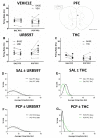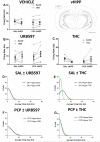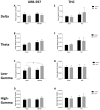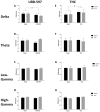THC and endocannabinoids differentially regulate neuronal activity in the prefrontal cortex and hippocampus in the subchronic PCP model of schizophrenia
- PMID: 26510449
- PMCID: PMC5252830
- DOI: 10.1177/0269881115612239
THC and endocannabinoids differentially regulate neuronal activity in the prefrontal cortex and hippocampus in the subchronic PCP model of schizophrenia
Abstract
Cannabis use has been associated with an increased risk to develop schizophrenia as well as symptom exacerbation in patients. In contrast, clinical studies have revealed an inverse relationship between the cerebrospinal fluid levels of the endocannabinoid anandamide and symptom severity, suggesting a therapeutic potential for endocannabinoid-enhancing drugs. Indeed, preclinical studies have shown that these drugs can reverse distinct behavioral deficits in a rodent model of schizophrenia. The mechanisms underlying the differences between exogenous and endogenous cannabinoid administration are currently unknown. Using the phencyclidine (PCP) rat model of schizophrenia, we compared the effects on neuronal activity of systematic administration of delta-9-tetrahydrocannabinol (THC) with the fatty acid amide hydrolase inhibitor URB597. Specifically, we found that the inhibitory response in the prefrontal cortex to THC administration was absent in PCP-treated rats. In contrast, an augmented response to endocannabinoid upregulation was observed in the prefrontal cortex of PCP-treated rats. Interestingly, differential effects were also observed at the neuronal population level, as endocannabinoid upregulation induced opposite effects on coordinated activity when compared with THC. Such information is important for understanding why marijuana and synthetic cannabinoid use may be contraindicated in schizophrenia patients while endocannabinoid enhancement may provide a novel therapeutic approach.
Keywords: THC; electrophysiology; endocannabinoids; prefrontal cortex; schizophrenia; ventral hippocampus.
© The Author(s) 2015.
Figures







References
-
- Anderson C, Horne JA. Prefrontal Cortex: Links between Low Frequency Delta Eeg in Sleep and Neuropsychological Performance in Healthy, Older People. Psychophysiology. 2003;40:349–357. - PubMed
-
- Association., A.P. Diagnostic and Statistical Manual of Mental Disorders. Fourth Text Revision (Dsm-Iv-Tr); Washington, DC: 2000.
-
- Borgwardt SJ, Allen P, Bhattacharyya S, Fusar-Poli P, Crippa JA, Seal ML, et al. Neural Basis of Delta-9-Tetrahydrocannabinol and Cannabidiol: Effects During Response Inhibition. Biol Psychiatry. 2008;64:966–973. - PubMed
Publication types
MeSH terms
Substances
Grants and funding
LinkOut - more resources
Full Text Sources
Other Literature Sources
Medical

